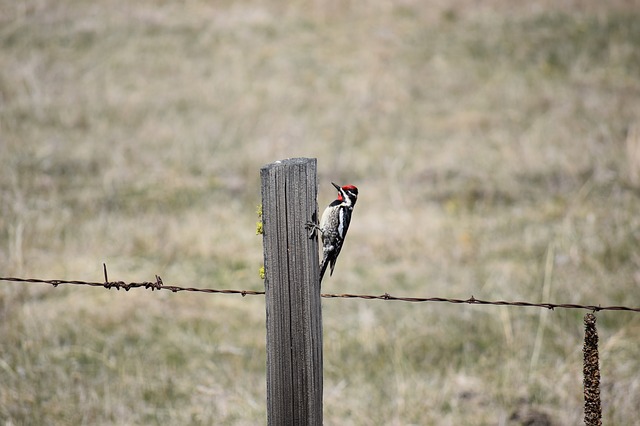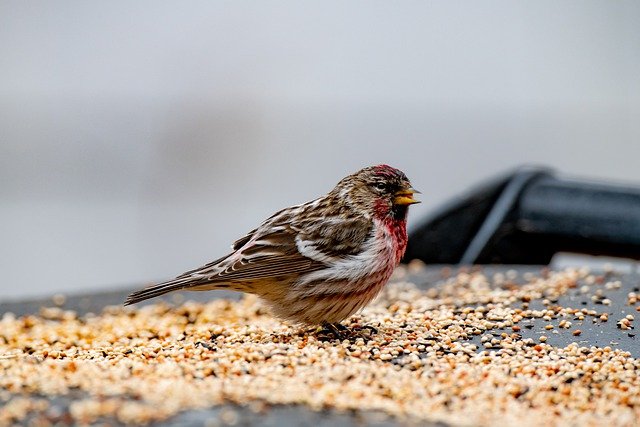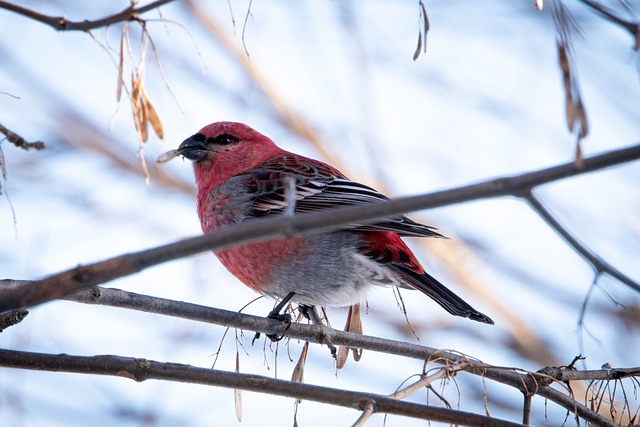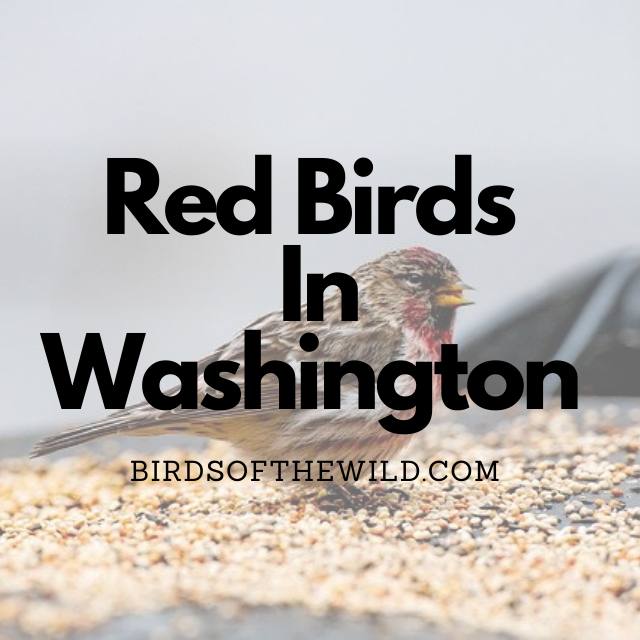You can find a variety of red birds in Washington so, if you’ve found yourself on this article, I’ll be going over 7 unique red birds in Washington that consider the state as their home.
- House Finch
- Red Naped Sapsucker
- Northern Flicker
- Common Redpoll
- Pine Grosbeak
- White Winged Crossbill
- Red Breasted Sapsucker
7 Red Birds In Washington
1. House Finch (Haemorhous Mexicanus)

- Size: 12.5 – 15cm
- Weight: 19 – 22 grams
- Wingspan: 20 – 25cm
House finches can be found in Washington all throughout the state on a year round basis.
A House finch can be recognised by its red and brown plumage with their body mostly light brown and the head made up of a gradient red color with hints of brown. Females on the other hand are mostly brown with hints of black on their wings and back.
As for where you can find house finches, the number of habitats they stay within are quite vast ranging from dry desert, desert grassland, chaparral, oak savannah, streamsides, and open coniferous forests at elevations below 6,000 feet.
If the food is to their liking, like black sunflower seeds, these little birds will on occasion make their way to a feeder set out by a citizen. Other than seeds house finches also eat small insects like aphids as well as fruits and berries.
In the wild, house finches are known to live for around 10 years whilst captive finches can live upwards of 12 years.
2. Red Naped Sapsucker (Sphyrapicus Nuchalis)

- Size: 19 – 21cm
- Weight: 32 – 66 grams
- Wingspan: 41 – 43cm
You’ll be able to find red naped sapsuckers in the eastern region of Washington when they happen to be breeding.
Red naped sapsucker are recognised by their black and white striped pattern on their back, face and wings, with red around their chin and mohawk feathers on the head. Females follow a similar color scheme minus the mohawk feathers and red elements.
These birds will often spend their time around mountains in mixed coniferous and deciduous forest, especially around aspens.
As for what red naped sapsuckers eat, it includes insects, tree sap, berries and other fruits.
Red naped sapsuckers are known to live for around 4 – 5 years in the wild.
3. Northern Flicker (Colaptes Auratus)

- Size: 30 – 35cm
- Weight: 115 – 125 grams
- Wingspan: 50 – 55cm
These northern flickers can be found in the state of Washington year round as it’s one of their many places of permanent residencies within the states.
Northern flickers are recognised by their mostly cream colored body with black spots, orange and black tail feathers and elements of red on the lower part of their face. Females look very similar to the males minus the red elements on their face.
You’ll often find northern flickers around woodlands, forest edges, and open fields with scattered trees, as well as city parks and suburbs.
As for what they tend to eat, it includes mostly insects along with smaller fruits and berries.
Northern flickers are known to live for around 5 – 7 years on average with the longest recorded to be 9 years and 2 months.
4. Common Redpoll (Acanthis)

- Size: 12 – 14cm
- Weight: 11 – 20 grams
- Wingspan: 19 – 22cm
Common redpolls can be found in the central and eastern part of Washington throughout their non-breeding seasons. This would typically be when it’s fall and winter.
These common redpolls are recognised by their red, white and brown plumage with their forehead and breast mixed with red and white, with the wings a combination of a brown and white color. Females also have a little spot on their forehead but, the remainder of their body is a brown and white color.
You’ll find a common redpoll located around boreal forests of pines, spruces and larches.
As for what these birds eat, it includes seeds from birch, alder and spruce along with a bunch of small insects like caterpillars, beetles, flies etc.
The longest lifespan that was recorded for a redpoll happened to be around 7 years and 10 months but, the majority of redpolls will live a good bit shorter, between the 4 – 5 year range.
5. Pine Grosbeak (Pinicola Enucleator)

- Size: 20 – 25.5cm
- Weight: 52 – 58 grams
- Wingspan: 31 – 35cm
You’ll be able to find pine grosbeaks in the northern central part of the state year round.
Pine grosbeaks are recognised by their greyish white wings and tail feathers, a redish pink body and head along with a black beak and feet. Female grosbeaks are not nearly as vibrant as the males with their plumage a generally light gray color with hints of orange around the torso and tail.
Pine grosbeaks spend the majority of their time within coniferous woods where the may straddle on a horizontal branch when resting and hunt for small insects, seeds, buds, berries among other refreshing fruits when on the move.
These birds are known to live up till 9 years old, sometimes even more so they have a moderately long lifespans for birds of their size.
6. White Winged Crossbill (Loxia Leucoptera)

- Size: 15 – 17cm
- Weight: 24 – 30 grams
- Wingspan: 26 – 28cm
White winged crossbills are mostly non breeding residents within Washington although in some regions near the center, they do appear to remain at the state year round.
These white winged crossbill (also called two barred crossbills) are recognised by their red plumage across the head and body, black wings with white stripes and their downward pointing bill that crosses over itself. On the other hand females are mostly gray and green in color.
These crossbills can be found living in montane coniferous forests among boreal trees with mature spruce and larch. As for what the two barred crossbill eat, it includes pine cones, grass, docks, thrift seeds as well as smaller insects like caterpillars, aphids, spiders etc.
White winged crossbills are also known to live for around 4 years in the wild although the numbers may differ for captive ones.
7. Red Breasted Sapsucker (Sphyrapicus Ruber)

- Size: 20 – 22cm
- Weight: 55 – 64 grams
- Wingspan: 37 – 41cm
You’ll be able to find red breasted sapsuckers in the western and coastline regions of Washington year round.
Red breasted sapsuckers are recognised by their red, white and black plumage. It has mostly black feathers with dalmatian like patterns on the wings and back, a red head and neck with a pointy black beak that helps these avians dig into trees to sap out its remains.
Other than tree sap these sapsuckers also consume fruits, berries and small insects like ants found at the trunk of trees.
You’ll catch these red faced birds hunting mostly in pine forests among other habitats where a number of trees are around.
Red breasted sapsuckers are known to live quite a short life in the wild generally being around 2 – 3 years although living in captivity would likely double if not triple this.
Amhil Khan, a dedicated nature enthusiast and the founder of BirdsOfTheWild.com, is a passionate advocate for the captivating world of avian wonders. With a deep-seated curiosity about the intricate lives of birds, Amhil’s journey began as a fascination and has evolved into a mission to inspire others to appreciate and protect these magnificent creatures.
Amhil’s love for birds led to the creation of Birds of the Wild, a platform where his expertise in ornithology, coupled with his captivating storytelling, provides readers with an immersive and educational experience. Through his lens and words, he captures the essence of birds in their natural habitats, offering a glimpse into their behaviors, migrations, and the ecosystems they inhabit.

